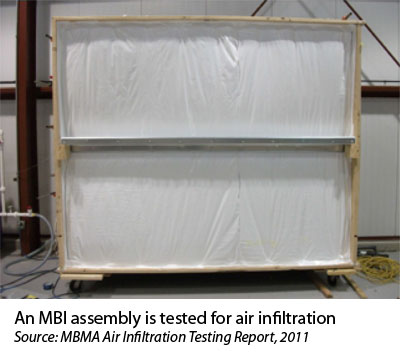Metal Building Air Leakage Requirements, Testing and More
 One of the most common challenges faced by contractors is minimizing air leakage in the building envelope, which includes roof and wall assemblies, doors, windows, skylights and other components that lead to an opening in the building. Air leakage can be caused by a number of factors, including wind pressure and issues with mechanical systems, among others.
One of the most common challenges faced by contractors is minimizing air leakage in the building envelope, which includes roof and wall assemblies, doors, windows, skylights and other components that lead to an opening in the building. Air leakage can be caused by a number of factors, including wind pressure and issues with mechanical systems, among others.
So, when it comes to air barrier requirements for commercial code compliance, it’s important to know that there are two air barrier code compliance options within ASHRAE 90.1 and IECC:
- Materials and Assembly Testing
- Blower Door Testing
1. Materials and Assembly Testing
This is the easier of the two options to use. The materials and assembly testing is just that – a test of only the building’s air barriers and the manner in which they are assembled to various components within a building, such as doors, windows, corners, etc. In order to be considered a true air barrier material, the product must pass the air barrier material requirement in both ASHRAE and IECC. All Lamtec facings, as well as the OptiLiner® fabric facing, have passed this requirement.
Below are the results of air infiltration and ex-filtration tests performed for the Metal Building Manufacturers Association (MBMA) by the NAHB Research Center. The NAHB Research Center evaluated the air sealing effectiveness of different metal building assemblies.

Below are the OptiLiner® fabric/vapor barrier tests. It’s important to take note of the Air Permeance for Building Materials ASTM rating (the last line item in the table), as D2178-3 meets ASHRAE and IECC’s requirement for the materials and assembly test.
Many states only require materials and assembly testing. However, it is very important to check your state’s status during each new code cycle (typically 2 – 3 years) to make sure this has not changed.
2. Blower Door Testing
This compliance option tests air leakage of the entire building as a whole. Typically, a blower door is mounted to the frame of a walkthrough door and is used to pull the air out of the building in order to lower the air pressure indoors. Then, the higher air pressure from outside enters the building through all unsealed openings, which is used to calculate the air infiltration rate of the building. You can read more about blower door tests on the U.S. Department of Energy’s site. The information pertains to residential construction, but the same principles apply for commercial.
What’s key to remember here is that, once the blower door testing path is selected, you can’t opt-out and elect to undergo materials and assembly testing later. If your building fails the blower door test, you must make all repairs until it passes it. Thus, I recommend hiring an air barrier consultant if a contractor, architect or city requires blower door testing.
The allowable air leakage for materials, assemblies, and whole building are as follows:
Check back for my next post in November, which will cover commercial building insulation retrofit systems. Until then, visit our metal building insulation page for data sheets and other helpful information related to insulation and energy codes.
Want to make sure you don’t miss out on the latest energy code updates?
Subscribe to our energy code newsletter to get blog posts sent directly to your inbox.
MORE BLOGS
COMcheck™: A Live Demo with Bill “The Code Man” Beals
Join Bill “The Code Man” Beals Thursday, October 26th at 2:15 p.m. ET for a free COMcheck™ demonstration. Participants will earn 1 AIA LU/HSW and/or a certificate of completion.
Mid-Year Energy Code Update
I’ve been on the move and traveling the country, giving energy code presentations and attending industry meetings. In this mid-year energy code update, I’m sharing the trends I’ve observed from state to state, with a focus on the challenges and opportunities the IECC 2021/ASHRAE 90.1-2019 energy code cycle poses for metal building contractors, erectors, and designers.
Commercial Energy Codes & MBI: What to Know In 2023
Happy 2023, folks. We’re kicking off the new year with something a little different: A video summary of the current energy code landscape, plus what you need to know as we move into 2023. I also cover the metal building insulation systems that meet the most...
This Just In: Several States Adopt New Commercial Energy Codes
It’s officially the start of fall, folks, and you know what that means: A quick commercial energy code wrap-up. Here’s a short-and-sweet update on what’s been happening around the country. Also, are you attending METALCON? Join me for a free AIA-accredited course on...
Commercial Energy Code Update: What to Know for 2022
Learn more about the top commercial energy code updates you need to know for 2022.
2020 Code Update: Taking A Look At The Remainder Of The Year
Let’s dive into the top building envelope code updates you need to know for the rest of 2020.
Metal Buildings & Energy Codes: A Webinar With The Code Man
Join me Thursday, November 14th at 1 p.m. ET for a free webinar on the metal building envelope code changes you need to know. Participants will earn 1 AIA LU/HSW and/or a certificate of completion.
2019 Commercial Energy Codes Update
I got together with the folks at Metal Construction News and Metal Architecture to organize a webinar that will summarize the key commercial energy code information I’ve talked about over the past year.


